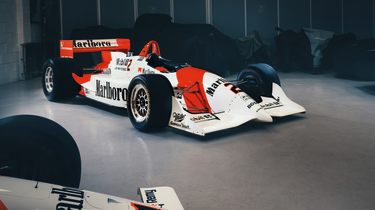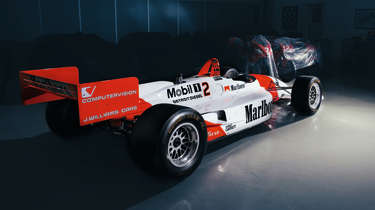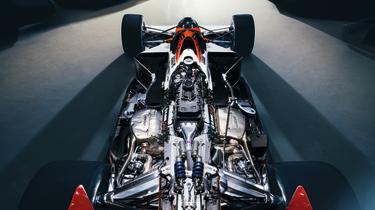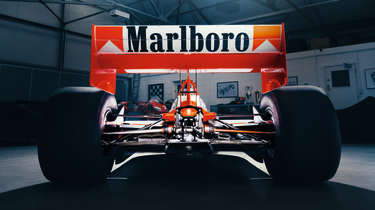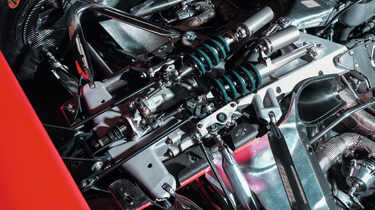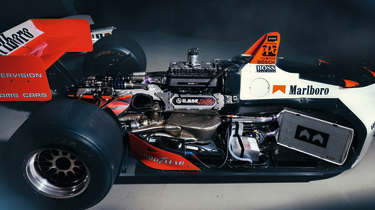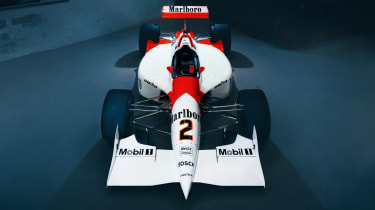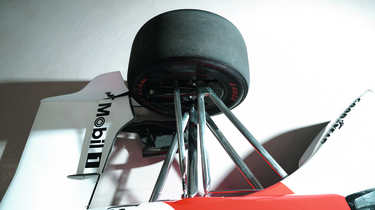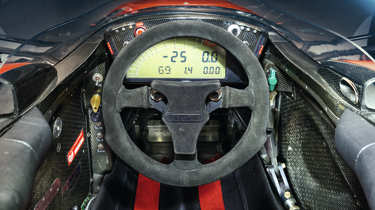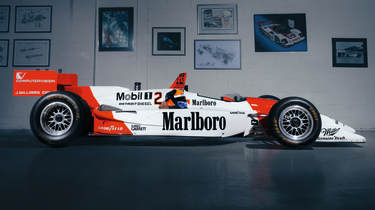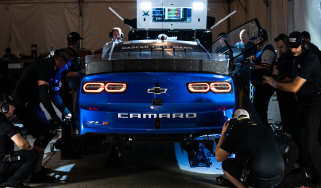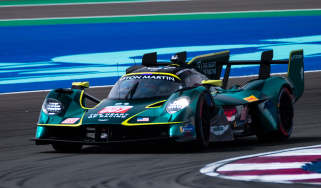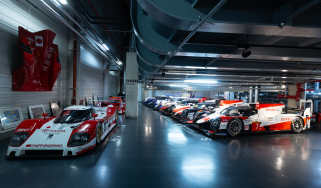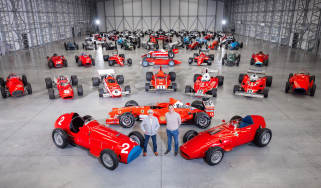Penske PC23: the anatomy of a 253mph IndyCar icon
For a while in the ’90s, IndyCar challenged Formula 1 as the premier form of motorsport; we look under the skin of a Penske PC23 from the series’ golden era
Before the calamity known as ‘the split’ in Indy racing circles, the CART (Championship Auto Racing Teams) IndyCar series was America’s premier single-seater racing category and a genuine rival to Formula 1. Indeed, as the series spread to Australasia and South America, and eventually even Europe, the power brokers of Grand Prix racing became increasingly nervous, a fear fed by Nigel Mansell’s defection after his F1 title year to IndyCar for 1993 and Ayrton Senna’s test of Brazilian countryman Emerson Fittipaldi’s Penske-Chevrolet in 1992 (also sponsored by Marlboro, like Senna’s McLaren-Honda). It seemed that IndyCar truly could become a world series.
CART had been formed after team and car owners became dissatisfied with USAC, the sanctioning body that ran the US’s top-flight single-seater racing championship. USAC was the baby of Indianapolis Speedway owner Tony Hulman, and increasingly throughout the 1970s the teams felt the series was being poorly run and with too much emphasis on the Indy 500 race and not the overall championship. CART was formed in 1978 and by 1982 was in overall charge, with only the Indy 500 running under USAC but now forming part of the CART series, which in time would be named ‘IndyCar’. Nevertheless, this complex political arrangement between Indianapolis and everyone else was fraught with hazards that in time would lead to the downfall not only of CART, but also see a tremendous decline in the standing and popularity of single-seater racing in the US; it was an open goal for NASCAR.
> Mazda 787B: the anatomy of a rotary Le Mans icon
The IRL (Indy Racing League), the Indianapolis Motor Speedway’s own single-seater championship, began in 1996, and although CART enjoyed some classic seasons from that point onwards, it eventually went into decline, going bankrupt in 2003. The series limped on, rebranded as Champ Cars and effectively became a one-make ‘spec series’ until the two championships were ‘combined’ once again in 2008.
The subject of this story takes us back to the year 1994 and the heyday of CART, with a growing number of chassis and engine manufacturers, and top class drivers, from American household names to an increasing influx of foreign stars. Given the challenge of racing on a mix of dedicated racing tracks, street circuits, short ovals and super speedways, both car and driver had to be versatile, resilient and, of course, fast.
Racing history
The story of the 1994 IndyCar season is one of a championship and a team – Penske Racing – at its zenith. Following Nigel Mansell’s surprise championship success the previous year, when the Englishman narrowly beat Penske’s Emerson Fittipaldi to the title, Roger Penske left nothing to chance in 1994. The team expanded to three cars, with 1990 champion Al Unser Jr joining ‘Emmo’ and young charger Paul Tracy, and the PC23 would have the latest version of the 265 V8 –known as the ‘D’ model and now badged as an Ilmor following Chevrolet’s withdrawal – to call on. Moreover, Penske had an ace up his sleeve for Indy, with a unique engine ready to make a shock debut.
Ranged against Penske were the Lola-Fords of Newman/ Haas Racing, with champion Nigel Mansell and Mario Andretti in his farewell season. It was not to be a great title defence for ‘Our Nige’, however, with three pole positions all there was to show before he returned to F1 for an ill-advised part-year with McLaren. In total, 33 drivers scored points out of the 64 that contested races throughout the season, among them returnee Michael Andretti driving for Chip Ganassi in Reynard’s debut year as a chassis constructor in IndyCar, Jacques Villeneuve in Forsythe-Green’s Reynard-Ford, and a young Robby Gordon in a Lola-Ford.
By the end of the year, Unser had scored eight wins, Tracy three, and Fittipaldi one, out of a total of 16 races. Unser was a deserved champion, and Penske won the teams’ title. Penske would build eight PC23s for the 1994 season, with a ninth built for 1995 when it was delivered straight to Bettenhausen Racing.
This car is chassis number 08, and its only race was at Cleveland on the Burke Lakefront Airport circuit for round eight of the PPG Cup. Driven by Emerson Fittipaldi, it qualified third and retired from third when an exhaust broke. For much of the rest of ’94 it was used for testing purposes, before being sold to and raced by the Bettenhausen team in 1995 and ’96.
Body, chassis & aerodynamics
Although they were single-seaters (or ‘open-wheelers’ in American parlance) IndyCars of the ’80s and ’90s differed significantly from their more European-based Grand Prix counterparts. IndyCars were heavier, stronger – beefier might be a good description – but in many ways almost as sophisticated. The common misconception is that they’re bigger than contemporary F1 cars, but that isn’t true, and given that F1 had banned electronic driver aids for the 1994 season, the PC23 was far from crude in comparison.
Perhaps the key difference between the two formulas was the minimum weight mandated: just over 700kg (1550lbs) for the IndyCar, versus 100-150kg less in Grand Prix racing at the time, depending on the year. The IndyCar had to withstand the 200mph+ crashes into concrete that are an obvious peril of racing on ovals, and was tested accordingly.
As with F1 cars, IndyCars had switched to monocoque construction after Team Lotus arrived on the scene in the late 1960s (and indeed, from front-engined to mid-engined), and aluminium tubs were the order of the day well into the 1980s. Perhaps mindful – and accordingly conservative – of the requirement to survive immense impacts on ovals, and of the cost of carbonfibre, the new material was not universally adopted, and the key IndyCar constructors used a carbon upper tub with an alloy lower section into the 1990s. March and Porsche unveiled a full carbon car for 1990, but it was banned after protests, although the series switched to all-carbon a year later.
The PC23 for the 1994 season was the work of chief designer Nigel Bennett and his team, based at Penske Cars in Poole, UK. Roger Penske was unusual in preferring to build his own chassis, unlike most other teams who sourced theirs from companies such as Lola, March and, later, Reynard. While the Penske racing team was based in the US, both the car and engine were designed and built in the UK.
The new machine was a logical development of the previous season’s car, with attention paid to the weight distribution and, in particular, the short-oval aerodynamics, which were optimised for new rules that demanded smaller wings. ‘I spent a lot of time to get that right,’ recounts Bennet today. ‘The fact the car had to work on different [types of] circuits gave designers more of a challenge.’
Unlike F1, IndyCars used full-width tunnels along the car to create downforce, with restrictions on their size and angle, supplemented by wings front and rear on the upper surface. ‘A large proportion of the downforce was generated underneath the car,’ confirms Bennett, and the car also featured a blown diffuser many years before the technology was applied to F1 by Red Bull. On the PC23, the tailpipe on the left-hand side exits above the diffuser to create extra downforce on the inside rear wheel on ovals; on later cars the turbo wastegates exited either side at the rear to ‘seal off’ the diffuser from turbulence created by the rear wheels. The radiators are ducted inside, through and out of the side-pods.
The PC23 won a remarkable 12 out of 16 races, but Bennett is disarmingly modest about his creation: ‘I made fewer mistakes with that car than usual, and you make a lot of mistakes in designing cars.’
Engine and gearbox
In the CART era, the formula for pure racing engines revolved around a maximum displacement of 2.65 litres, with turbocharging allowed and the cars running on methanol fuel. The latter had been adopted in 1965 instead of gasoline after a series of terrifying, fiery crashes culminating in a huge pile-up at the 1964 Indy 500 that saw two drivers lose their lives in the inferno (IndyCar racing switched to ethanol in 2006, and to renewable ethanol for 2023).
By the mid-1980s the engine to have in CART was the Ford Cosworth DFX V8, a turbocharged, down-sized version of the equally all-conquering 3-litre, naturally aspirated Cosworth DFV in F1. Even so, two Cosworth engineers had become disillusioned at the pace of development and believed they could make something better. That pair was Mario Illien and Paul Morgan, who left to set up Ilmor Engineering, and with the backing of Roger Penske managed to lure Chevrolet into financing a new V8 for IndyCar racing. Ilmor would go on to design the V10 engines for Mercedes in F1, and was latterly bought by Mercedes to become what is known today as Mercedes-AMG High Performance Powertrains, and is still based in Brixworth, Northamptonshire.
The result was the Ilmor 265/A, a 2.65-litre, four-cam 90-degree V8 with a bore and stroke of 88.0 x 54.4mm and blown by a single turbocharger fed by both banks, reputedly producing around 775bhp. As with all IndyCar engines, ultimate boost was controlled via a ‘pop-off valve’, which would be momentarily triggered if the pressure was exceeded. The engine had its first dyno run in May of 1985 and its first run in a car during August of the same year at Bruntingthorpe airfield. The engine’s debut year, 1986, was a difficult one, with numerous mechanical failures, but in 1987 the first victory was secured and by 1988 the Chevrolet Indy V8 was the engine to have. Chevy-powered cars won the championship from 1988-1992 inclusive, and also every Indy 500 held during that same period.
For 1992, Ilmor developed the ‘B’ version of the 265 V8, with 80 per cent new components and weight reduced from the 147kg of the original to 134kg. It was also lower and narrower than the ‘A’, but it lasted only one year; for 1992 the ‘C’ spec engine arrived, which was again largely new. This time the block’s vee angle was reduced to 80 degrees, for the benefit of aerodynamics, and it was lower and narrower again, and had lost another kilo in weight. Nevertheless, the Cosworth engineers had responded, and their new ‘XB’ V8 powered Nigel Mansell’s Lola to an epic championship title. The tightly packaged Ford engine was thought to offer more top-end power than the Chevy, but without as much low-down torque.
Ilmor responded for 1994 by introducing the ‘D’ version of the now classic 265 (now badged as an ‘Ilmor’ following the end of the Chevrolet partnership), this time adopting a new block with an 82-degree vee angle, and a further 10kg weight reduction. By now the ‘D’ engine was thought to be good for around 875bhp.
However, there was another engine being developed for the PC23 at Brixworth, and for just one race only. The Indy 500, then the world’s biggest one-day sporting event, was still part of the CART calendar before the split, but tensions were rising between teams, owners, governing bodies and scrutineers. To give the traditional ‘stock block’ V8 runners a chance, pushrod engines were allowed a larger displacement (3.4 litres) and more generous turbo boost limits to run in the 500. When the requirement to base the engine on a production engine was taken away, Penske and Ilmor spotted an opportunity…
In complete secrecy – in case rivals or the organisers spotted the loophole and closed it before the race – they designed a purpose-built, 3.4-litre pushrod V8 that produced over 1000bhp and 557lb ft of torque. ‘The Beast’, as it became known, or the Mercedes-Benz 500I V8 to give it its true title once the German firm had joined the project, won its one and only race with Al Unser Jr taking his second Indy 500 victory, clocking 256mph down the main straight in the process.
The 265/D was renamed the Mercedes-Benz IC108 in 1995, and, for the glory years of the ’90s, CART also enjoyed engine manufacturer participation from Japanese marques Honda and Toyota, having seen both Porsche and Alfa Romeo try but ultimately fail at the start of the decade.
Having traditionally used H-pattern manual transmissions up until the end of the 1992 season, IndyCars switched to a sequential shift (though still with a lever, not paddles) in 1993, and during the 1994 season the PC23 moved from a five- to a six-speed ’box. Changes were clutch-less on the way up but required the clutch on the way down (unless you were Al Unser Jr, apparently). The PC23 used a limited-slip differential with a viscous clutch-pack, something that gave it a traction advantage out of slow corners compared with rivals.
Suspension, tyres and brakes
Penske had developed its own active suspension system in 1993, hydraulically controlled rather than electronically ‘active’, but the system was outlawed before it was raced. Nevertheless, the project taught the team the importance of controlling the car’s ride height, hence the inclusion of a secret third spring on the PC23 for added control. The double wishbones are steel, not carbon, which was mandated due to reasons of cost and ultimate strength, and the brake discs were metal too, although carbon brakes were allowed for super-speedway races.
Much of the magic of getting an IndyCar to run at the front of the field was down to set-up. As well as bespoke aero packages and conventional suspension tuning, cars set up for oval use would run with wheels cambered in the same direction and tyre stagger (different tyre sizes on each side to compensate for not running a limited-slip differential on ovals).
Driving them: Mark Blundell
Former F1 star and sportscar driver Mark Blundell raced for the PacWest team in CART between 1996 and 2000, and during a storming 1997 season won at Portland, Toronto and Fontana Speedway on his way to sixth overall in the championship. ‘Unlike F1, these were customer cars from constructors, but they were still one of the most enjoyable cars I drove: multi-purpose, and accomplished at all disciplines,’ recounts Blundell today. ‘Mainly because they had 900bhp-plus and no power steering, traction control… every input to the steering and throttle had an output, and the guy stuck in between the two pieces of carbonfibre had the biggest effect on the outcome. To drive them you had to almost go retro. Even with gearchanges: compared to the paddleshift of F1, you had to think about every shift, especially in the wet.
‘It was a heavy car – heavy in construction, so that added to it too, and it was incredibly physical. All the drivers found them rewarding to drive. With steel brakes, the braking distances were longer [than F1], so you could line someone up, draft them, and then with longer braking distances had more margin to get the job [overtaking] done. I’d never been a left-foot braker, but on an oval you have to, especially on a short oval. It is an art. When it’s wrong, it’s the worst; when it’s right, it’s some of the best racing you can experience.
‘I don’t think you ever feel 100 per cent comfortable [on a super-speedway]. When I actually watched it standing outside at the first corner it scared the living daylights out of me, and I said “I’ll never do that again!”. Your brain has to recalibrate, because tiny changes can make all the difference at 225mph-plus. I did 253mph on the straight and 227mph in the corners – that’s another level to F1, and with 25 guys around you in a vacuum of air. If I’d been in an F1 car in Rio (Blundell survived a huge crash during his first season, hitting the wall at 200mph and recording a 122g deceleration, which resulted in broken bones and internal injuries] I’d be dead. The cars always felt very robust…’
Running one today
It’s not hard to see why owner Patrick Morgan has a deep-seated love of IndyCars. Not only did he work in the series when it was in its prime, but his late father, Paul Morgan, was co-founder of Ilmor Engineering. Patrick has a stunning collection of PC19, 23, 26 and 27 Penskes and has run them at selected events through his Dawn Treader Performance company.
‘You can run one,’ he says, ‘but you have to be disciplined, and experience goes a long way. The biggest issue is the fuel: you have to remove it from the tank and purge the injection system if you leave the car standing for more than a few days. Methanol has a voracious appetite for bare aluminium and O-rings – that’s why all the alloy you see is anodised, but if it’s scratched it will corrode quickly. We refer to the purging process as “pickling” the engine, which is running it on petrol for 10-15 seconds to flush the methanol out, otherwise you end up with a white residue that can block the injectors. Having said that, it is easy to get the fuel, and as it’s a single-molecule fuel it’s less volatile than petrol. You can compress it a lot without “knocking” and you can put a fire out with water – although the flame is invisible…
‘Temperature management is critical. These cars take a long time to warm up, and they weren’t designed for standing starts, so if you stop they do suffer from heat soak – they’re used to being cooled by passing air. The fuel in the plenum’s fuel rail will heat up, vaporise and that locks the injectors shut, then the engine won’t start. You can also blister and burn the bodywork easily, as it’s tightly packaged. That said, used in their intended environment they’re fine. We flush the brake and clutch fluid every time, and ’90s cars have data-logging, which helps.
‘Six months ago you needed a period laptop to run one, but I now have the original software running as a virtual machine on a modern computer, thanks to work I’ve done here.’
This story was first featured in evo issue 321.

